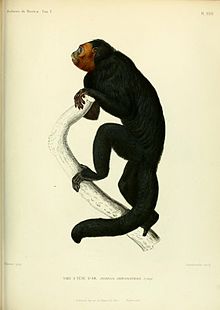Gold face kaki
| Gold face kaki | ||||||||||||
|---|---|---|---|---|---|---|---|---|---|---|---|---|

Golden faced kaki ( Pithecia chrysocephala ), male |
||||||||||||
| Systematics | ||||||||||||
|
||||||||||||
| Scientific name | ||||||||||||
| Pithecia chrysocephala | ||||||||||||
| I. Geoffroy Saint-Hilaire , 1850 |

The golden face kaki ( Pithecia chrysocephala ) is a primate species from the group of the New World monkeys . It occurs in an area north of the lower Amazon between the mouths of the Rio Negro and Rio Nhamundá and in a small area west of the mouth of the Rio Negro in the Amazon around the cities of Acajutiba , Iranduba and Manacapuru .
The IUCN lists the golden face kaki as not endangered (least concern) .
features
The golden face kaki is similar to the white head kaki ( P. pithecia ). Males are almost completely black, including the hands and feet. The hairy face mask is not white, but orange to reddish brown, the hairless skin around the eyes, nose and chin is black. Females are grayish, finely speckled light-dark, have an orange breast and the mouth region is bordered by orange lines. Young animals are more like females than males.
Golden face jackets reach a weight of 1.9 kg, a head-torso length of a maximum of 47 cm (males) or 30 to 44 cm (females) and are 34 to 45 (males) or 33 to 40 (females) cm long tail.
Systematics
The golden face kaki was described by the French zoologist Isidore Geoffroy Saint-Hilaire in 1850 . The American mammalogen Philip Hershkovitz assigned the form to the white-headed saki ( P. pithecia ) as the subspecies P. pithecia chrysocephala in 1987 . In a revision of the Sakis published in 2014, the golden faced kaki was again placed in the rank of a species, as it differs significantly from P. pithecia in phenotypic and skull morphology. The boundary between the distribution areas of both species is still unknown. Sakis observed between the safe ranges of both species show a mix of characteristics of both species and are possibly hybrids.
literature
- Laura K. Marsh. 2014. A Taxonomic Revision of the Saki Monkeys, Pithecia Desmarest, 1804. Neotropical Primates. 21 (1); 1-163.
Individual evidence
- ↑ Pithecia chrysocephala in the endangered Red List species the IUCN 2017. Posted by: Mitter Meier, RA, Veiga, LM & Marsh, LK, 2015. Accessed March 15, 2018th
- ↑ Stephen F. Ferrari, Liza M. Veiga, Liliam P. Pinto, Laura K. Marsh, Russell A. Mittermeier & Anthony B. Rylands: Family Pitheciidae (Titis, Sakis and Uacaris). Page 475 in Russell A. Mittermeier , Anthony B. Rylands & Don E. Wilson : Handbook of the Mammals of the World - Volume 3: Primates. Lynx Editions, 2013 ISBN 978-8496553897